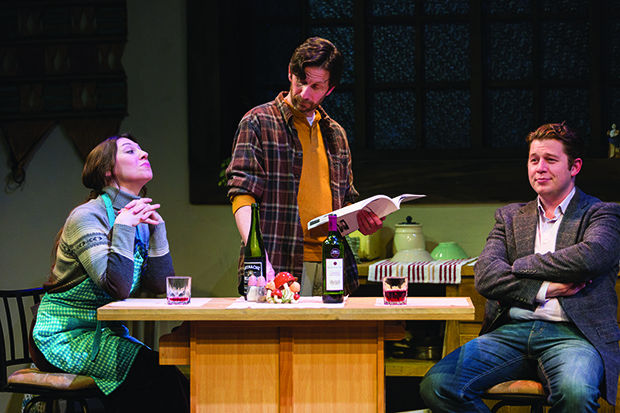‘Sight Unseen’ deserves to be widely seen at NJT
Published March 18, 2015
“Sight Unseen,” a complex drama of ideas and identity by acclaimed playwright Donald Margulies, is given a gripping, first-rate production at the New Jewish Theater with skilled direction by Bobby Miller and a top-drawer cast.
The play interweaves the lives of its central characters with serious issues involving artistic integrity, ethnic loyalty and betrayal, and the lingering tensions of ex-lovers who try to come to terms with their painful estrangement decades earlier.
Married actors Aaron Orion Baker and Emily Baker are perfect as Jonathan Waxman, a once struggling young Brooklyn-born Jewish artist who has become wildly successful, and Patricia, who evolved from his nude model to become his lover and muse. Their relationship ended badly, leaving both of them emotionally wounded.
Patricia has moved on with her life to become a self-described “American expatriate” living in a cold farmhouse in Norwalk, England, with her painfully shy second husband, Nick. Patricia does not have the same romantic and erotic passion for Nick that she had shared with Jonathan, but the two of them share an interest in archaeology. What gets these two excited is the recent discoveries of a Roman garbage dump.
David Wassilak is excellent in the challenging role of Nick, who switches back and forth between professorial detachment and lacerating sarcasm toward Jonathan. To Nick, Jonathan seems like a hypocrite and a sellout to the very shallow, middle-class values Jonathan lampoons in much of his work. Jonathan’s paintings evoke images that are similar to those depicted by Eric Fischel, scenes of banal middle-class families who are shown without clothing doing everyday tasks.
Jonathan, who rose rapidly to become one of New York’s “hot” artists, has become so much in demand by wealthy art patrons that his works in progress are being snapped up “sign unseen” even before they have been completed. One of his earliest works is a nude portrait of Patricia from the earliest days of their relationship, a simple work that radiates the love energy the two of them once shared. Patricia keeps that painting above her mantel in her country home, which discomfits Nick, who is envious of the love that his wife once shared with its artist.
When Jonathan has a major retrospective scheduled in London, he drops in on Patricia and Nick for a visit that churns up unresolved feelings, lingering attraction and resentments over their breakup. The scenes among Jonathan, Patricia and Nick are filled with tension as the characters circle one another like boxers in a three-way match, each trying to score points on the other and then bobbing and weaving to avoid the counterpunches. Miller’s deft stage direction of his skilled cast is evident as the scenes unfold.
The subtext of the play involves the age-old dilemma of the American Jewish artist. Should Jonathan Waxman, who was raised in an Orthodox Jewish Brooklyn home where he was strictly forbidden to date non-Jewish girls, be considered a “Jewish” artist just because of that background? Or should his self-definition as an American artist who happens to be Jewish be respected?
Those issues are deeply explored in two interview scenes in which Jonathan is quizzed by Grete, an art who critic baits him about his Jewish background and in the process forces him to confront issues he would rather not. Em Piro is spot-on as the inquisitional Grete, whose strong German accent and sarcastic smile do disguise her excellent command of the English language.
One of Jonathan’s most controversial paintings depicts an African-American male making love to a white woman in a Jewish cemetery that has been desecrated with swastikas. Jonathan was struggling to come to terms with the Holocaust and ethnic issues in that painting, and yet he had to respond to feminist critics who protested that the woman’s hands were clenched like fists, suggesting she was being raped rather than engaging in consensual sex. Patricia and Grete both raise similar issues about that particular painting, to the extreme discomfort of Jonathan, who cuts off the interview with Grete in the same savage way he ended his original relationship with Patricia.
Despite all of his material success and artistic acclaim, Jonathan remains conflicted about his Jewish identity, his artistic integrity, the lack of wisdom and judgment in his personal relationships and his failure to recognize the simple power of his lovingly created portrait of Patricia.
The production is greatly enhanced by the highly skilled NJT production staff. Kudos to production manager Aemi Tucker, and to Brian Macke for coordinating the complex scene changes, which go back and forth in space and time. Some of the scene changes are time-consuming, but the end results are worth the wait.
Overall, “Sight Unseen” is a powerful personal drama involving delicate relations among former and present lovers, artistic integrity and the sometimes unintended consequences of achieving too much success too soon.
WHEN: 7:30 p.m., March 18, 19, 25 and 26; 8 p.m. March 22 and 29
WHERE: Wool Studio Theatre at the Jewish Community Center, 2 Millstone Campus Drive
HOW MUCH: $38-42
MORE INFO: newjewishtheatre.org or 314-442-3283















